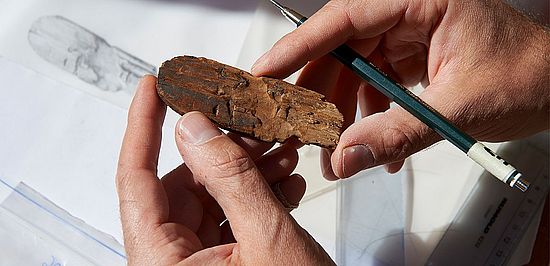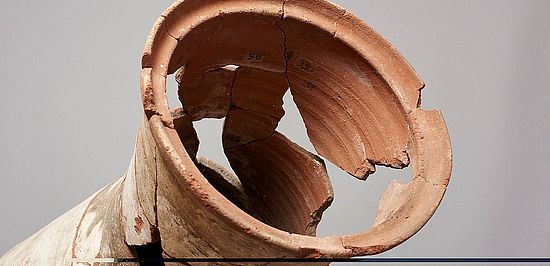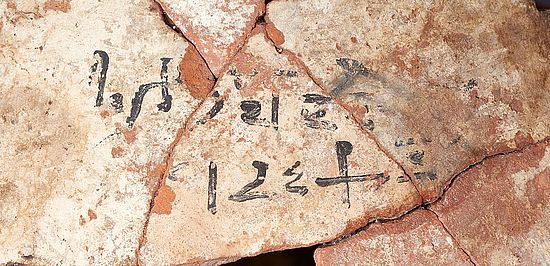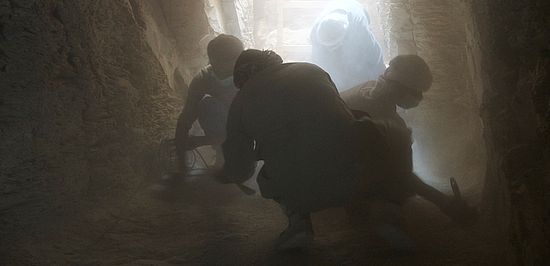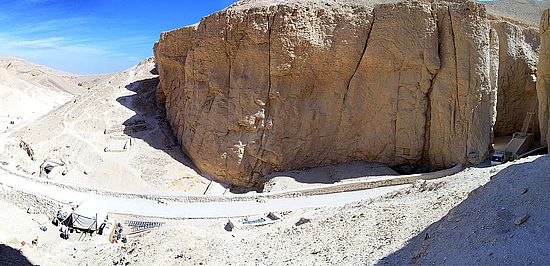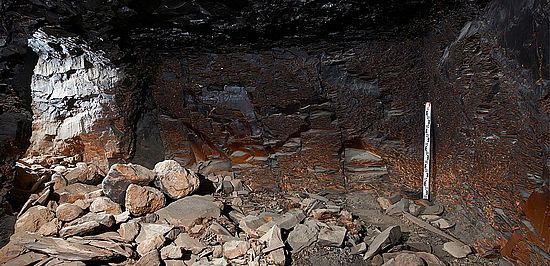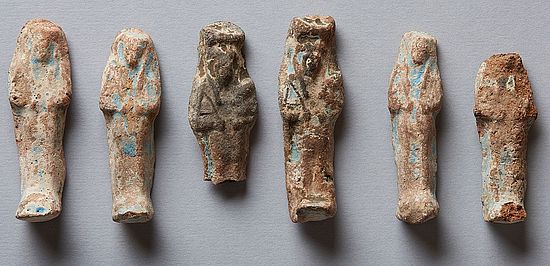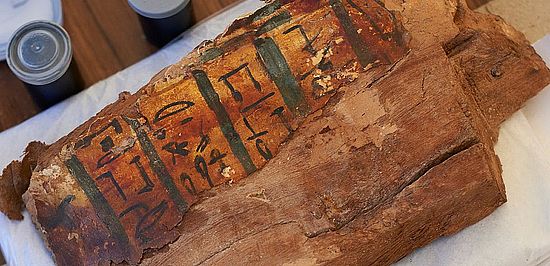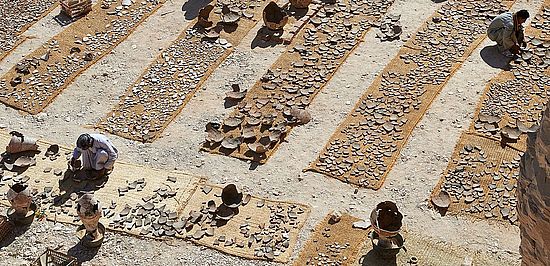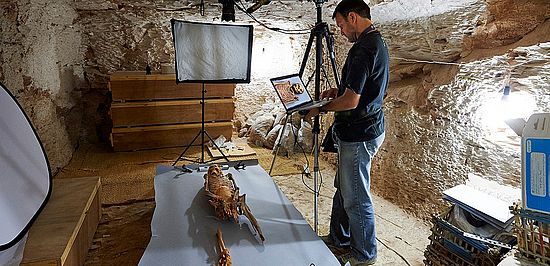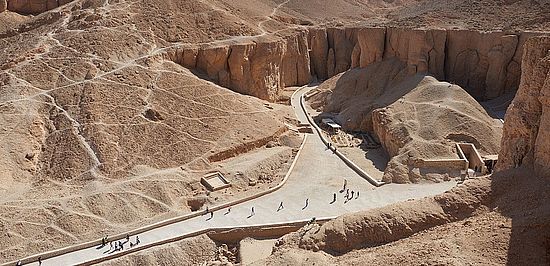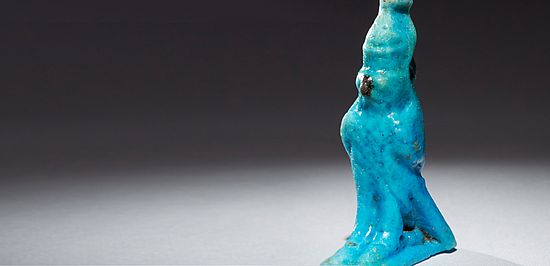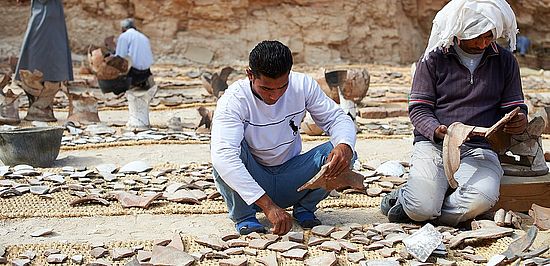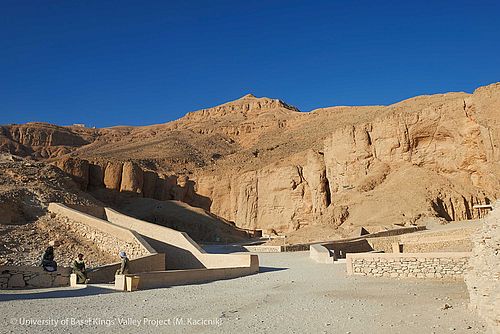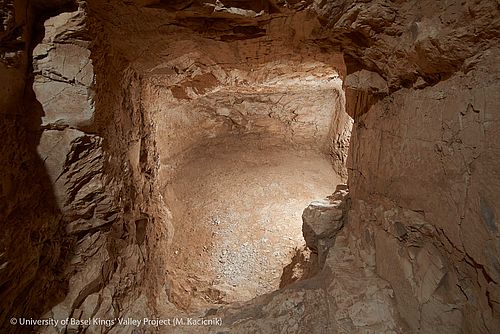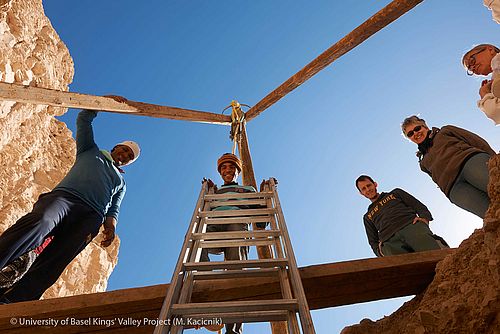University of Basel Kings' Valley Project – Welcome!
The University of Basel Kings’ Valley Project has been granted permission by the Egyptian authorities to explore the non-royal tombs situated in the central area of the Valley of the Kings - a privilege not granted to many foreign teams. The concession allows for the detailed exploration of 12 tombs and their environs.
The tombs found in the Valley of the Kings (which belong to the UNESCO World Heritage) have only in part been documented and published. In addition, large areas of the valley have remained unexplored – a fact that is of concern, due to the impact of natural and human influences currently present. In the face of these factors, our objective has become to secure the valuable information these tombs have to offer and to make it available to future researchers and to the public at large.
The University of Basel Kings’ Valley Project has especially dedicated itself to the preservation and documentation of these endangered historical tomb structures and has initiated a site management programme to ensure the protection of the tombs and their surroundings.
Early in the year of 2012 - after several years of preparatory work - our team discovered a new tomb in the Valley of the Kings (KV 64) and identified over 30 18th dynasty princes and princesses in a hitherto unexplored tomb (KV40).
Our recent campaigns have brought to light much historical information pertaining to the use of the Valley of the Kings from the 18th to the 25nd dynasty (ca. 1550 - 650 BC). In many cases, we were also able to identify the socially high-ranking persons buried here as well as the material provisions made for them.
Current work in KV 40 and in other still unexplored tombs within the concession area during the coming years, promises to produce further highly important results relative to tomb use during the time span between the dynasties mentioned above.
It is a pleasure for me to introduce my team and our project to you.
Excavation Director & Head of the Department of Egyptology
Research

Egyptology at the University of Basel can look back on a long tradition in regard to the exploration of the Valley of the Kings. The earlier campaigns have contributed substantially to the success of the current University of Basel Kings’ Valley Project.
Since the early 1970’s, Erich Hornung, former director of the Seminar of Egyptology at the University of Basel, has, within the framework of his studies of the old Egyptian funerary texts, recorded and analysed the highly complex decorations found in the pharaonic burial chambers.
In the 1990’s, emphasis began to change and the focus moved away from the royal burial grounds (necropolis), as the “official” side of the valley, and more towards the exploration of aspects of daily life as found in the valley (i.e. its “unofficial” side). This approach found its implementation in the “Mission Siptah – Ramses X” project (MISR).
Between 1998 and 2007, University of Basel Egyptologists excavated the most southern part of the valley. In recording their results, they considered not only the royal tombs, but for the first time also put the other tombs found, into their topological, chronological and socio-historical perspectives.
The motivation to initiate our current project goes back to the MISR project and to the identification of one the tombs (KV 32) in the side valley of Tuthmosis III as the burial site of Tiaa, the consort of Amenophis II. This attribution has raised new questions as to the use of the area and to the identity of the individuals buried there.
The University of Basel Kings’ Valley Project is currently conducting research into the following issues:
Topography
What meaning is there to be found in the relationship between the natural and the artificial topography laid out in the side valley? What meaning can be ascertained from the spatial relationships between a tomb site and special landmarks? Is the position of a tomb site to be understood in relationship to the royal tomb and to other non-royal tombs in the area?
Architecture
Is there a relationship between the social status of the entombed persons and the architecture of their tombs? Can the different sizes and layouts of the non-royal tombs be explained with regard to the background of social relationships? Why are the tombs not decorated and where were the funerary and memorial rites performed?
Chronology
What is the chronology of the side valley of Tuthmosis III and were there successive phases of use? When did the use of the side valley as a burial ground for non-royal persons begin and how long was this period of time?
Agency
What impact did the disuse of the Valley of the Kings as a pharaonic necropolis have on tomb use in the area? Was the choice of a tomb and the burial rites performed during the 3rd Intermediate Period systematic or of a more individual nature (agency)?
Social identities
What social and genealogical relationships were in effect in the side valley i.e. which people had the privilege of being buried within the direct vicinity of the king?
Robberies
Tomb robbery in the Valley of the Kings was systematic and already took place in ancient times. Who were the perpetrators and what was their financial and ideological background?
Tombs
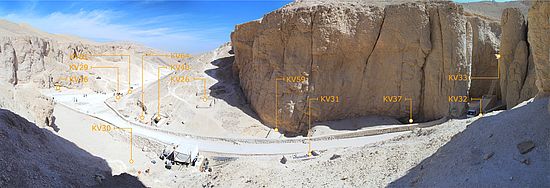
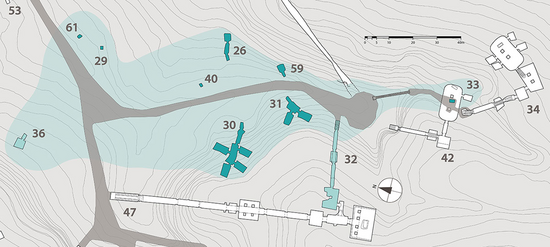
This first campaign supplied information concerning tombs, probably discovered by Victor Loret in 1898, but for which no records exist. As a first step the area and the shafts of KV 26 and KV 30 have to be cleared of modern debris.
The architecture of the tomb and the ceramic objects found, indicate that they date back to the middle of the 18th dynasty.

Rediscovery of tomb KV 59, which may have originally been discovered by Howard Carter. Work begins in KV 31 and in the surface area around KV 40. Surveying in the concession area with particular emphasis on the graffiti - abounding on the cliffs - left behind by pharaonic workers and officials. Documentation of the painted Ramesside cult niche situated on the eastern flank of the Valley of the Kings.
KV 59, a one-chamber tomb, yielded practically no finds and could be dated to the 18th dynasty. Apparently, the tomb had been flooded by rainfall and debris deposited. Excavation of the shafts of KV 29 and KV 40. KV 29 has been marked on the map of the Valley of the Kings since 1825, but no exploration of the tomb has as yet taken place. During surface area work around KV 40, an anomaly in the terrain was discovered and labelled KV 40b.


KV 40b proves to be a new tomb and has been re-labelled KV 64. The contents of the tomb have remained undisturbed (no evidence of robbery). The tomb contains the remains of Nehemesbastet, “ Chantress of Amun”. Evaluation of her coffin and an accompanying wooden stele points to the 22nd dynasty. Under the filling layer, burial remains dating to the 18th dynasty are found.
KV 33 has a step entrance and is located beside the tomb of Tuthmosis III (KV 34). Exploration of the tomb reveals ceramic objects, but no clues indicating for whom the tomb was built. This tomb had apparently been explored by Victor Loret and his team.
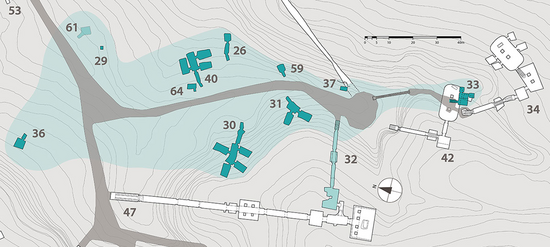
Excavation and documentation of KV 64 is completed and the focus is again on the mass burial in KV 40. Work begins with the recovery and documentation of the numerous mummy remains in the side chamber D - many of which have been damaged by tomb robbers and fire. In the terrain between KV 29 and KV 61 a limestone fragment (ostracon) with a painted sundial on its surface is discovered – worldwide the oldest of its kind.
The side chambers in KV 40 are cleared. Recovered potsherd display ink writing (dockets), naming some of the individuals buried (including title e.g. Prince, Princess) here. Altogether KV 40 contains over 80 male and female mummies of different ages (including infants), along with their burial objects, all dating back to a time span between the 18th and 22nd dynasty.
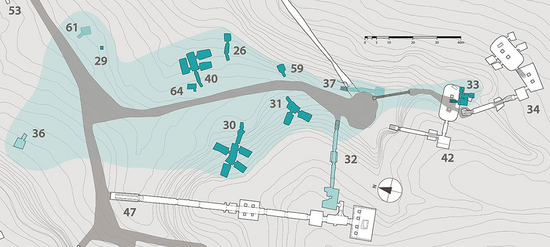
The focus is on the documentation and evaluation of the complex findings of the tombs KV 40 and 64. The location of the buried tomb KV 37 is rediscovered and the entrance to the low-lying tomb secured. The grave proves to be largely empty. The surface area around KV 40/64 is excavated and documented.
Further insights into the history of the side valley are expected by the excavation of the graves KV 29, KV 61 and the work in the area of the iron staircase to the tomb of Thutmosis III. With 12 graves under investigation, the Basler team's concession extends from the tomb of Maiherperi (KV36) in the west to the royal tomb of Thutmose III (KV34).
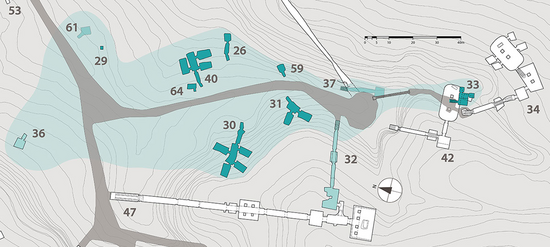
The analysis of the mummies from KV40 and KV64 as well as the large amount of textiles and embalming residues are progressing. Based on the medical examinations, the number of individuals buried in KV40 and their state of health can be determined. C14 and DNA analyzes are ongoing and promise insightful results in the coming months.
Excavations around KV40 / 64 serve to reconstruct the historical topology of the valley floor. The exposure of KV 61 will connect to the north-located shaft grave cluster in the vicinity of the tomb Amenhotep II (KV 35). The developing tourism in the Valley of the Kings demands pragmatic and safety-related solutions for the routing and protection of the excavation areas.

The tombs in the Valley of the Kings present us with 2 kinds of entrance structures: a step entrance passage leading to a corridor, or a shaft.
Corridor tombs
A typical feature of tombs with corridors is access by means of a more or less steeply downward inclined entrance corridor (sometimes with steps at the beginning or with periodically intervening steps). Usually a second, slightly downward inclined corridor leads away from the entrance area to the burial chamber (e.g. KV 32 and KV 37). KV 33 differs in this regard in that the entrance staircase leads directly to a central chamber with a transversal axis and several adjoining chambers.
An additional architectural feature of KV 33 came to light in the course of the University of Basel excavation and adds to the complexity of this tomb. In the eastern third of the main chamber the ground is ca. 20 cm lower than the remaining ground level. This feature is usually only found from the time of Amenophis II onward, the recess being used to receive the sarcophagus. The recess feature itself has not been found in tombs other than those designated for pharaonic use. The question that immediately arises here is: Who was originally supposed to be buried in KV 33?
Shaft tombs
The entering shafts are vertical in construction and several metres deep. At the end of the shaft an opening leads to an antechamber or directly to the main chamber. In more complex tombs of this type there are one or more adjoining side chambers projecting from the main chamber. Most tombs in the concession area of the University of Basel Kings’ Valley Project (KV 26, 29, 30, 31, 36, 40, 59, 61 und 64) belong to the shaft-tomb type.
Shaft tombs themselves present us with two kinds of layouts: a one-chamber structure and multi-chambered constructions.
The first type of shaft tombs is “simple” in that they are accessed by one shaft leading directly to the main or burial chamber (which is without adjoining chambers). Tombs KV 36, 61, 59 and 64 are of this type.
In the second type of shaft tombs the shaft opens to a corridor. Here we find two variants: a “simple” structure, where the connecting corridor leads to a single main chamber (e.g. KV26), and a more complex structure, where the corridor leads to a central chamber with several adjoining chambers. Tombs KV 30, KV 31 and KV 40 are of this type.

Decoration and sealing
In all the graves studied, the walls are neither smoothed nor decorated. Some tombs have red paint marks on the walls, which served the Pharaonic workers as a guide in the planned installation of the graves.
In KV 30, 31, 40 and 64 traces of initial blocking and sealing at the lower end of the shaft could also be detected. The process of blocking could be reconstructed on the basis of the salvaged stone and clay remnants as well as possibly used tools: Thus, the passage to the first chamber (B or J) was initially blocked with coarse rocks. In cups of the type of the so-called "flower pots", the Pharaonic necropoleous workers mixed the damp clay that was tempered with straw and applied to the stone block. In the moist clay the wooden stamp with the official necropolis sealing (Upuaut with 9 prisoners) were impressed. This seal was also used to block passages to the side chambers in KV 40.
Tomb KV 31, which probably dates to Thutmose III, showed at its blocking of the lower end of the shaft traces of a previously unknown seal type, whose motive is probably to be read as the gods name "Geb".
All graves of the 18th dynasty in the side valley Thutmose III were robbed. Some also suffered significant damage from flooding:

The archaeological context in the Valley of the Kings and the tombs, which has changed significantly over the past two centuries, represents a great challenge. The interplay of different disciplines helps to process this complex data:
Basic to a scientific approach to the research issues outlined above is a precise documentation of archaeological features and finds. Documentation procedures include archaeological illustrations, photographs, and to some extent 3-D modelling.
Follow-up work such as data organisation, analysis of features and finds and preparations for publication are carried out at the University of Basel.
Along with ceramic analysis (which yields important chronological information), the coming campaigns will be concentrating on the restoration of organic objects. Many of the objects and fragments have been damaged by dampness after flooding (KV 26, KV 59) or by fire (KV 40). For our project, it will be of central importance to stabilize and conserve these objects.
Those tombs which escaped flood damage (KV 31, KV 40, KV 64) contain significant amounts of objects / fragments of organic material (cartonnage and wood). Textile remains found in these tombs will be analysed by specialists from the Abegg Foundation, Riggisberg, Switzerland). The result will be a systematic documentation of the use of textiles as burial objects and for mummification purposes.
Mummy remains from KV 31, 40 and 64 have been analyzed on site by Professor Dr. Frank Rühli and his team (from the University of Zürich, Institute for Evolutionary Medicine and Swiss Mummy Project) as to age, sex, health condition and presence of any anatomical anomalies. The results have provided a deeper insight into the nutritional and hygienic habits, and social conventions at the pharaonic court of the 18th dynasty.
Animals were sometimes placed in the tomb along with the deceased, either as a sacrificial offering or as a food supply. The animal bones found in some of the tombs (e.g. KV 31) have been analyzed by Professor Dr. Salima Ikram of the American University of Cairo.
During the coming campaigns, surveying and mapping of the tombs located in the side valley will be continued. Based on the results obtained, we will better understand how the side valley came to be sacred ground and be able to consider which conceptions underlay the pharaonic necropolis of the 18th dynasty.
Along with the Egyptian Museum in Cairo, the Valley of the Kings is one the most frequented tourist attractions in Egypt. Sustainability is thus of increasing importance and excavation and clearing work should be precise and carefully conducted.
All cleared tomb shafts have been provided with an aboveground enclosure to protect visitors and to both prevent the accumulation of debris and flooding by washed-in rain. Low stone walls and sand-tinted metal roofs serve as protective structures and fit in harmoniously with the surrounding landscape.
Future planning includes a new roadway and several Info-Points offering visitor information.
Findings
Several tombs (KV 30, KV 33, KV 37, KV 59) were almost free of finds when they were excavated. Mainly KV 31, KV 40 and KV 64 contained large quantities of the original tomb equipment as well as the remains of mummification collected in large, white washed vessels. Despite the highly fragmented state of all objects, a surprisingly detailed picture of the identity and occupancy history of the tombs emerges from their analysis.
The Burials of the 18th Dynasty

Due to its proximity to the royal tombs of Thutmose III (KV 34) and Amenhotep II (KV 35) it was to be assumed that the persons buried in the shaft graves belonged to the innermost circle of the royal family. The quality of the grave goods and the mummies testifies to the high social status of the grave owners. However, it was only the discovery of numerous inscribed "mummy labels" and more than 100 dockets of vessels with hieratic administrative notes in KV 40 that provided certainty about their identity.
With the help of these inscriptions not only the persons buried in the grave can be identified by name; There are also references to the administrative institution to which these individuals belonged: Accordingly, KV 40 served as the burial place of family members of Thutmose IV and Amenhotep III, from the "household of the royal children". Meanwhile, at least 30 individuals have witnessed by name. From this group 8 persons carry the title of a "king's daughter" and four the title "king's son". Both infants (newborns / infants) and adults were buried in KV 40. None of the persons named on the "dockets" is known from other sources.
The Royal Harim

In addition to the royal children, another group could be identified within the persons named in the vessel inscriptions. As suggested by the clearly non-Egyptian names of these women, they were probably foreign women (Bint-Anat, Bascha, etc.). Partly the names have a direct relation to foreign areas ("Mistress of Punt"). The hieratic spelling of some names with the "Throwing Stick" -Determinative (Gardiner, Sign List T14 as a marker for "foreigners") identifies the individuals in question as non-Egyptians. It can therefore be assumed that in KV 40 u.a. foreign princesses may have been buried with part of their Egyptian and non-Egyptian followers. It is likely that these princesses came to the Egyptian court as part of a "diplomatic marriage." The fact that an apparently purely Egyptian funeral was organized for the non-Egyptian princesses and their companions raises questions about the identity formation and the degree of acculturation of these persons.
According to the discovery of the name tags from KV 40, a small, stele-shaped wooden tablet with name inscription was also found in grave KV 64 within the fragmentary remains of the burial of the 18th Dynasty. Called an otherwise unknown princess "Satjah" ("daughter of the moon god Jah)", which may have lived at the same time as the persons in KV 40.
The Burials of the 3rd Intermediate Period

The massive looting, which can be detected in KV 31 and KV 40, is likely to have occurred in the late 19th and 20th dynasties and caused significant damage to the grave inventory. The robbers seem to have targeted especifically on metal objects. Objects from these materials are therefore missing in the burial inventories.
KV 26, 31, 40 and 64 show traces of reuse during the 3rd Intermediate Period. While the the later burials in KV 26, 31 and 40 were apparently introduced without previous cleansing of the grave, the archaeological situation of KV 64 shows that the remains of the burial of the 18th Dynasty were initially covered with a layer of debris, before the coffin or the burial equipment were deposited on it. The burial equipment of the 3rd Intermediate Period consisted of a coffin, a few grave goods (stela, shabti box) and none (KV 64) or small amounts (26, 31, 40) of ceramics.
The numerous fragments of coffins and cartonnage, which could be recovered in KV 40, date – according to their style and iconography – to the 22nd dynasty. The coffin decoration of the singer of Amun, Nehemesbastet (KV 64) also stresses a fabrication during the IIIrd Intermediate Period. During this period the high priests of Amun and the priesthood of Month at Thebes filled the power vacuum that opened by the decay of the central power at the end of the 20th dynasty.
Galleries
Quick Links


